Even with all the, errr…. stuff that’s come down the pipes in a bit over a year, I was shocked – SHOCKED – to see that it’s been just over a year since I’ve posted anything here in ThreeStarOwl.com.
The less said about all that the better (I’m looking at you ID thief, Hurricane Norbert, prankish and bullying 2015 Monsoon season, Volkswagen, and anything else I may have forgotten that’s sucked the energy, concentration, and joie-de-vivre – not to mention short-term memory – out of me in the past 16 months).
So here’s last night’s Superbloodharvestocotillomoon Eclipse, shot from my driveway through ocotillo canes just as it’s coming out of totality. I’m pretty sure this was a narrow escape for the moon from the serpent’s bite of the Ocotillo’s thorny jaws (a lot like my escape from the past year). Clickit to embiggit, it’s better bigger:
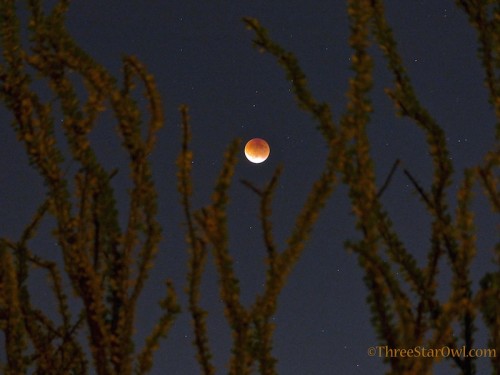
It’s International Vulture Awareness Day, so here’s some vulture verse. Or perhaps Vulture Culture?
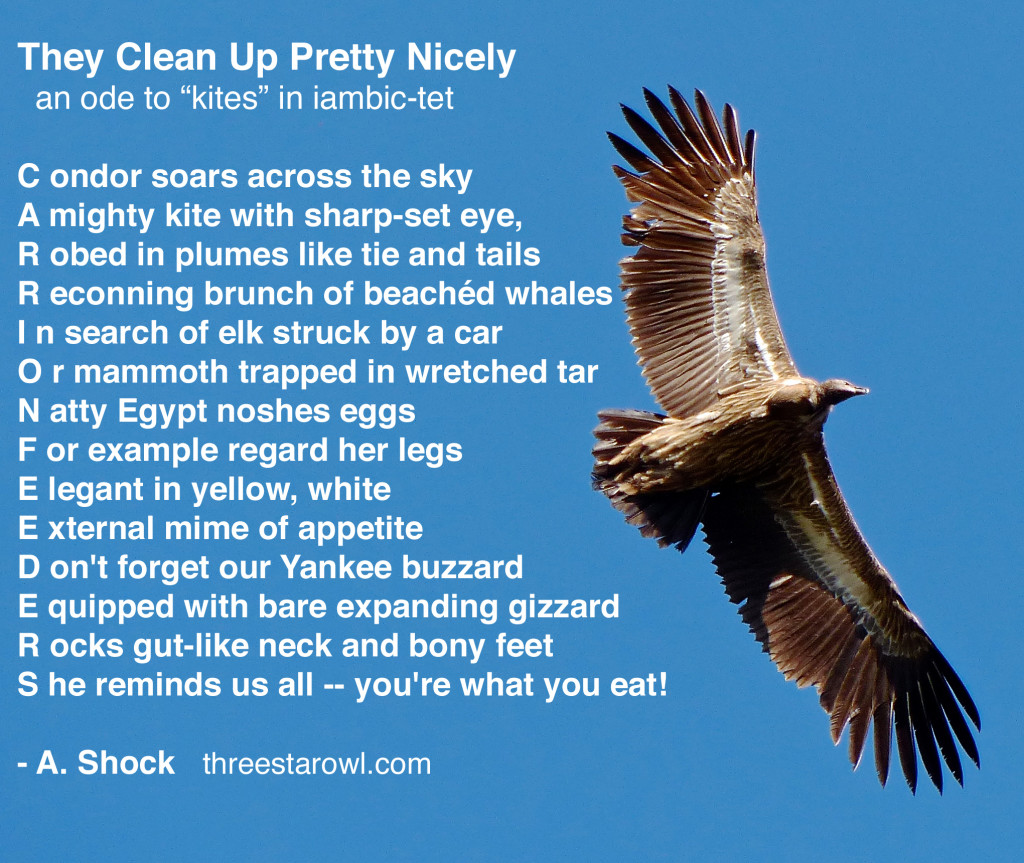
Poetic license categories: 1) the photo is of a Himalayan Griffon Vulture, not a condor (photo Uttarakhand, India, A.Shock 2014); 2) Egyptian Vultures do prefer to eat eggs, but it’s their entire color-scheme that’s yellow and white, with elegant white quills and bare yellow facial skin, which makes “legs” here a synecdoche, where a word for a part of something stands for the whole thing; 3) Kites are not vultures, they are kites, a different sort of raptor altogether, but the word “kite” has been used to refer to scavenging birds of prey for a long time, especially across the Pond; 4) likewise Buzzards are not vultures, but actually buteo-type hawks like the Red-tailed Hawk. The word “buzzard” is American vernacular for Turkey Vulture, widely used and understood in the U.S. As far as I’m concerned, the only downside of the usage is that it leaves a lot of Americans surprised when they find out we’ve got actual vultures overhead. That brings us full circle to the importance of International Vulture Awareness Day!
“Keep Calm and CarriOn!”
IMPORTANT UPDATE: The internet is full of mis-identified things, and I don’t wish to add to them. I’d like to correct my original mis-identification of the large fishing spiders who share our pool. They are Nursery-web spiders, Tinus peregrinus, and NOT Six-spotted. Happy to have had an expert’s id on this amazing arachnid.
The largish Six-Spotted Fishing Spider who took up residence in our swimming pool this summer has been missing for a couple of days. For the past two nights, I’ve gone out with a flashlight to look for him with no success, running the beam along the cracked tile edges and around the cement block angled on the top step for accidental swimmers to find a way out. I joked with E that maybe a lady fishing spider had found him to her liking.
But it turned out that was no joke. Tonight when I searched, there he was — lurking above the water on the side of the block ramp just like the last time I’d seen him. Then, looking more closely, I saw too many legs, and not in a good way. It seems the Cap’n had met his First Mate, who was also his last. His body was limp, hanging upside down from her grasp, or at least tangled in her limbs. I’m not an arachnid expert, it was dark and beginning to rain, and details were hard to make out. But here’s a photo (if you’re brave you can click on it to enlarge):
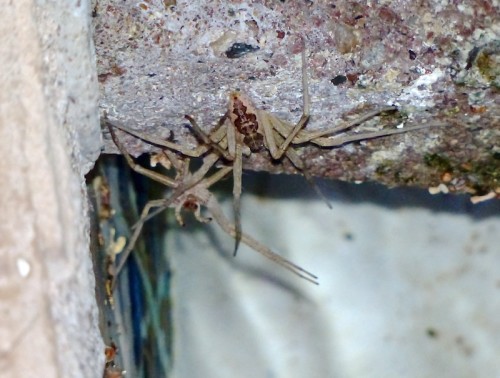
>> Fishing spiders in our pool. One of them is enjoying a little post-date predation. (Photo A.Shock)
Certain species of Fishing spiders are known for their male’s “self-sacrificing” mating habits, and that’s how I’m interpreting this poolside homicide. I suppose it could have also been a territorial dispute — I’ll never know. But if the “last supper” theory is correct, the lady is now gravid, perhaps explaining the gleam in her eye. (Actually, the tiny reflective gleam that’s visible if you enlarge the photo is my flashlight reflecting back from one of her retinas, like a cat’s eye in the dark).
Here’s some colorful literature on the “obligate death” scene of a Nebraska cousin (Dolomedes tenebrosus).
 [Updated 6 July 2014: I understand the urge to point out that spiders don’t chase people in swimming pools — the scenario seems unlikely, I agree. But with a gremlin looking on, who knows what curious occult forces were at work? Better?]
[Updated 6 July 2014: I understand the urge to point out that spiders don’t chase people in swimming pools — the scenario seems unlikely, I agree. But with a gremlin looking on, who knows what curious occult forces were at work? Better?]
The grainy photo below clearly shows a small gremlin in our pine tree (possibly the same one as here). It was making a soft tooting call that sounded exactly like the so-called “bouncing ball” call of the Western Screech-Owl.
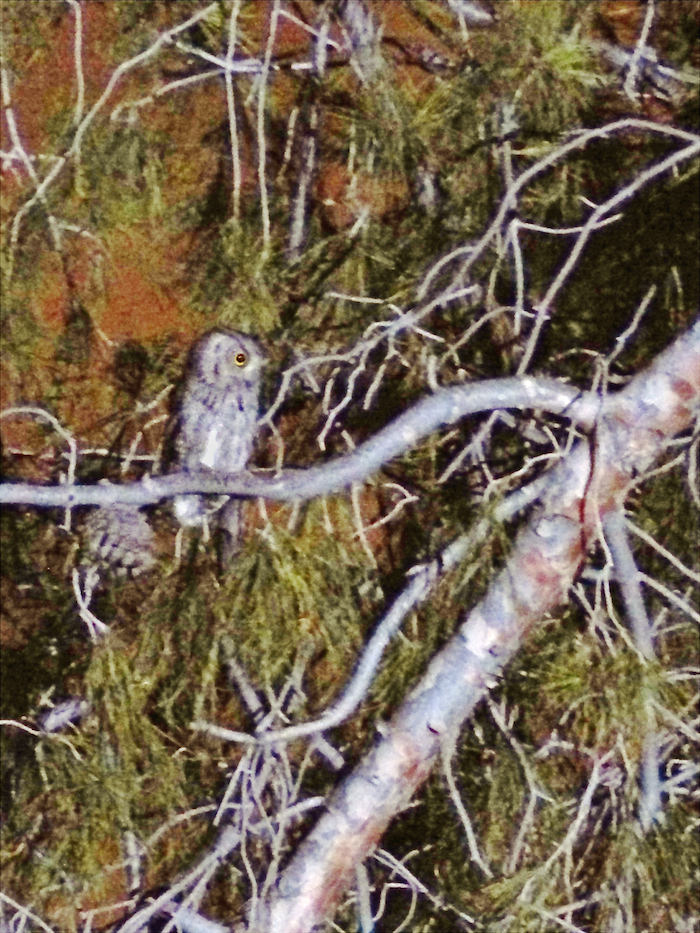
If I hadn’t captured the gremlin on camera, its clever vocal efforts to blend with the local avifauna would have been successful: in the dark, we would have assumed it was one of our local Screech-Owls, which are common in the yard, and which we’ve seen many times.
<< (Photo of Western Screech-Owl exhibiting HCQ — High Cranky Quotient — taken in ambient light with pinecone for scale, A.Shock 4 July 2014. You may click to enlarge, but it doesn’t get any better bigger.)
In this picture, the malevolent entity gazes down disapprovingly, caught in the act of watching the Six-Spotted Fishing Spider Nursery web spider chasing me — deliberately, I’m positive, and E will back me up on that — around the shallow end of the pool by skittering energetically and leggily across the surface towards me, repeatedly. The gremlin’s impersonation of a Screech-Owl is nearly perfect down to the tiny fierce talons grasping the branch, although IMO it needs to work on the “ear” tufts, which are frankly weak.
Bonus quote:
“He only has one eye!” — Peter Lorre, Beat the Devil (John Huston, 1953), on seeing a portrait in profile
Swimming after dark in our pool is currently an adventure, because we’re not the only ones in the water. The local Coast Guard makes frequent forays across the shipping lanes, issuing from his snug berth in a cavity between the edge-tiles at the shallow end.
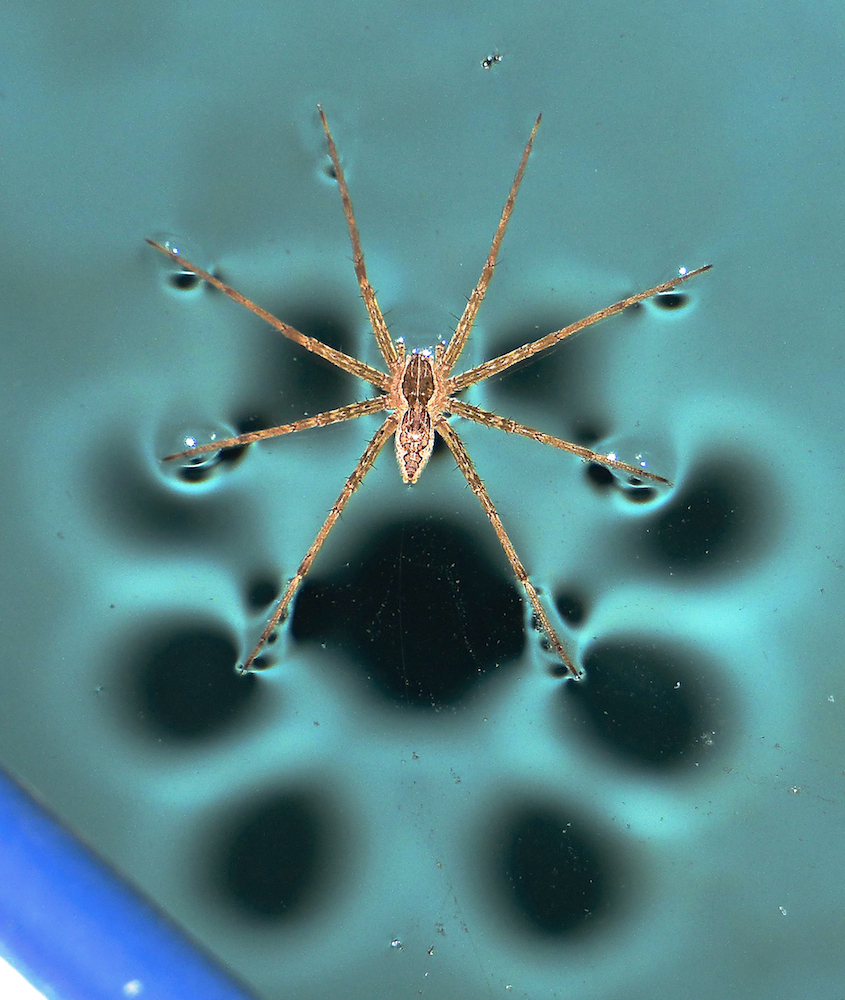
Here is the Coast Guard himself:
He’s a sizable male Six-Spotted Fishing Spider (Dolomedes triton, photo A.Shock). We think he’s male because of his trim abdomen and long leg-to-body ratio. And sizable as in “would-sit-on-the-palm-of-your-hand-with-only-a-little-to-spare.”
We’ve always had these handsome but intimidating spiders living around our pool — one, sometimes two at a time, each at opposite ends — holed up during the day and visible only as hair-thin leg-ends curled subtly around the edge of a cracked tile inches above the water. At night, however, they hunt, either hanging by their back legs with their sensitive front legs spread across the water, waiting for a surface-trapped insect to struggle by, or by speedily skittering across the taut surface, gleaning the day’s “tar-pit” casualties.
Fishing spiders are intensely aquatic, and will catch and eat anything they can subdue, including small fish — an item not on the menu in our pool, but there’s plenty of small invertebrates to feast on. The Coast Guard clearly finds plenty of nourishment: he’s grown quickly since we first noticed him earlier in the warm season.
Six-spotted Fishing Spiders are common water-side natives of Arizona and much of the United States. And in case you’re wondering, his eponymous spots are on the underside of his cephalothorax, but I’m not flipping him over to count!
…or perhaps merely a screech owl sitting on a sign in a neighbor’s yard.
You can’t see the little bird vibrating, but it was producing its distinctive whirring trill — that was how we found it.
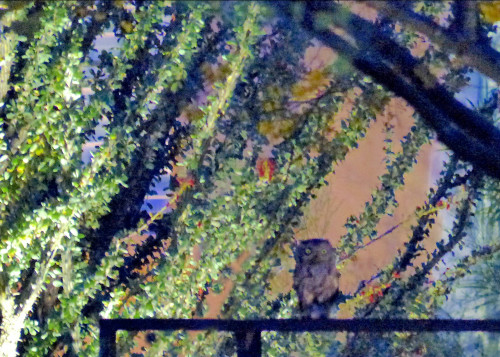
Western Screech Owl in front of an Ocotillo, Scottsdale, AZ. (Photo A.Shock, April 2014)
It was newly dark, and well beyond the camera’s ability to shoot anything like a real photo, especially without a tripod. But dinking around with the pathetic pixels in photo-editing software produced surprising detail and a painterly, almost pastel-like quality in this image of a small owl and its background, an enormous blooming ocotillo lit from below by landscaping lights.
…and I was, as usual…
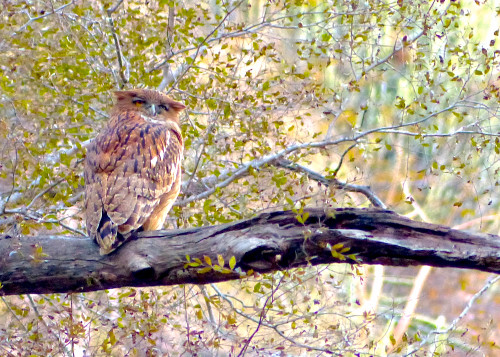 Here are portraits of two different Brown Fish Owls (Ketupa zeylonensis) spotted on my recent trip to northern India.
Here are portraits of two different Brown Fish Owls (Ketupa zeylonensis) spotted on my recent trip to northern India.
<< Brown Fish Owl, Ranthambhore Natl Park, Rajasthan, India (Click to enlarge, all photos A. Shock)
You might not be surprised that FISH Owls never stray far from permanent water features, where they feed mainly on aquatic prey. This owl (or one just like it) was later seen snacking on a water snake at dawn. Not sure what a water snake was doing within talons-reach of an owl on a cold January dawn, but now it’s owl cells.
Here’s the snake-snack, a Checkered Keelback Water Snake (Xenochrophis piscator) basking stream-side, maybe even the same individual, I’d photographed earlier:
Further north, in the Himalayan foothills, another Brown Fish Owl gazed down on us as we walked under its day perch in the Kumeria Forest Preserve near Nainital, Uttarakhand, India:
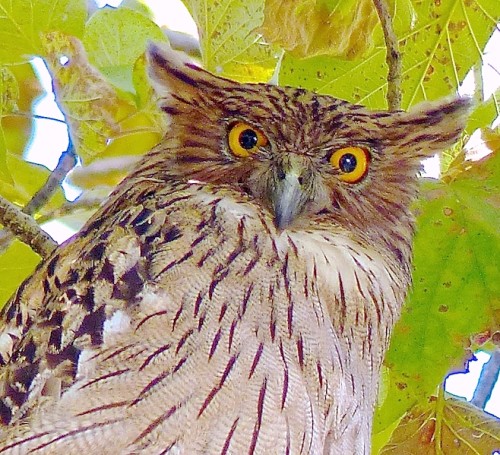
Brown Fish Owl knows you are up to no good (photo A.Shock)
On this theory, here are more owlets, Spotted again.
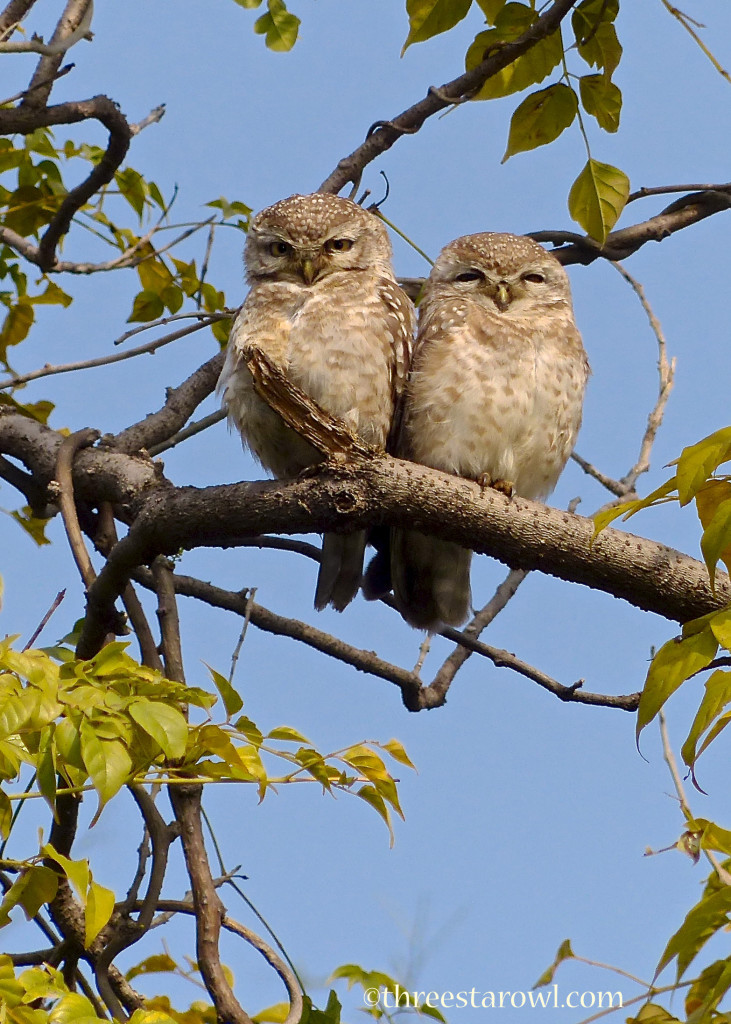
Spotted Owlets (Athene brama), photo A.Shock
This snuggly pair was day-roosting near Shiva’s old, golden temple in Keoladeo National Park in Bharatpur, India. When you are an owlet in India, a good perch is one the macaques don’t know about yet. Macaques are almost always up to no good, in my opinion.

Devi Lakshmi, the goddess of wealth and fortune, is often depicted with a white owl, which is her vārana, or symbolic mode of transport >>
I’m going to assume that an owl who can convey a deity is one of the larger species, and not an Owlet, but I’m no expert on where theology and ornithology intersect, or even if Kadam trees are a good place to find large owls, as this sign from the park seems to indicate:
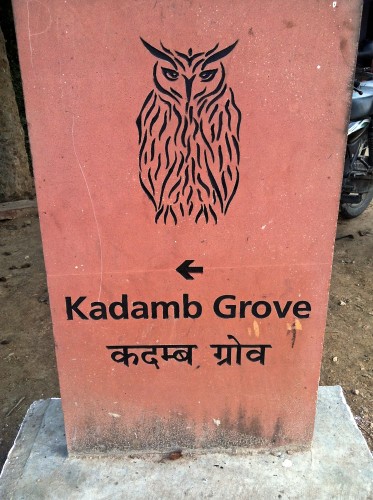

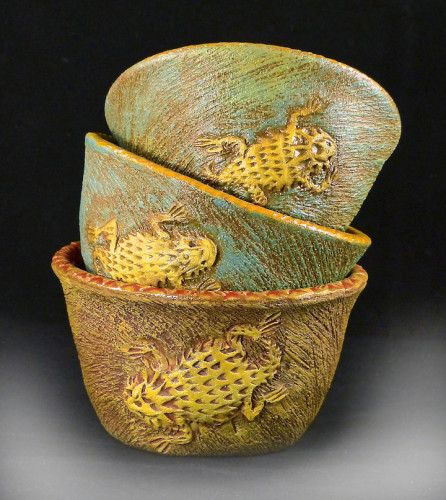
 Allison does not consider herself a wildlife artist,
but an observer who takes notes in clay.
Allison does not consider herself a wildlife artist,
but an observer who takes notes in clay.












